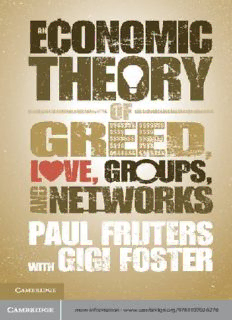
An Economic Theory of Greed, Love, Groups, and Networks PDF
Preview An Economic Theory of Greed, Love, Groups, and Networks
more information - www.cambridge.org/9781107026278 An Economic Theory of Greed, Love, Groups, and Networks Why are people loyal? How do groups form and how do they create incentives for their members to abide by group norms? Until now, eco- nomics has only been able to partially answer these questions. In this groundbreakingwork,PaulFrijterspresentsanewunifiedtheoryofhuman behavior. To do so, he incorporates comprehensive yet tractable defini- tionsofloveandpower,andthedynamicsofgroupsandnetworks,into thetraditionalmainstreameconomicview.Theresultisanenhancedview of human societies that nevertheless retains the pursuit of self-interest at itscore.Thisbookprovidesadigestiblebutcomprehensivetheoryofour socioeconomicsystem,whichcondensesitsimmensecomplexityintosim- plifiedrepresentations.Theresultbothilluminateshumanity’shistoryand suggests ways forward for policies today, in areas as diverse as poverty reductionandtaxcompliance. professor paul frijters is a professor of Economics at the University of Queensland. He was elected “Best Economist under 40 in Australia” by the Economic Society of Australia for 2009–2011, and his workconsistentlyranksinthetop4percentofdownloadedandcitedeco- nomicresearchintheworld.ProfessorFrijtershasundertakenresearchin awidevarietyoffields,includinghappinessandwell-being,migrationin China, behavioral economics, and health economics. The findings of his researchfeatureregularlyintheglobalmedia. gigi foster isaseniorlecturerintheSchoolofEconomicswithinthe AustralianSchoolofBusinessattheUniversityofNewSouthWales.Her research focuses primarily on decisions related to human capital, with a particularemphasisonsocialinfluenceandbehavioraleconomics. An Economic Theory of Greed, Love, Groups, and Networks paul frijters with gigi foster cambridge university press Cambridge,NewYork,Melbourne,Madrid,CapeTown, Singapore,SãoPaulo,Delhi,MexicoCity CambridgeUniversityPress TheEdinburghBuilding,CambridgeCB28RU,UK PublishedintheUnitedStatesofAmericabyCambridgeUniversityPress,NewYork www.cambridge.org Informationonthistitle:www.cambridge.org/9781107678941 ©PaulFrijtersandGigiFoster2013 Thispublicationisincopyright.Subjecttostatutoryexception andtotheprovisionsofrelevantcollectivelicensingagreements, noreproductionofanypartmaytakeplacewithoutthewritten permissionofCambridgeUniversityPress. Firstpublished2013 PrintedandboundintheUnitedKingdombytheMPGBooksGroup AcataloguerecordforthispublicationisavailablefromtheBritishLibrary LibraryofCongressCataloguinginPublicationdata Frijters,Paul. Aneconomictheoryofgreed,love,groups,andnetworks/PaulFrijters withGigiFoster. pages cm Includesbibliographicalreferencesandindex. ISBN978-1-107-02627-8–ISBN978-1-107-67894-1(pbk.) 1. Avarice. 2. Economicman. 3. Reciprocity(Commerce) 4. Socialgroups. 5. Socialnetworks. I. Title. BJ1535.A8F752013 306.3–dc23 2012043730 ISBN978-1-107-02627-8Hardback ISBN978-1-107-67894-1Paperback CambridgeUniversityPresshasnoresponsibilityforthepersistenceor accuracyofURLsforexternalorthird-partyinternetwebsitesreferredtoin thispublication,anddoesnotguaranteethatanycontentonsuchwebsitesis, orwillremain,accurateorappropriate. Contents Listoffigures page ix Preface xi Acknowledgments xv Introductionandpreview 1 Part I Greed and love 39 1 Individualmaterialism,organizations,andpower: Theviewfrommainstreameconomics 41 1.1 HomoEconomicus:Humansasindividualrational wealthmaximizers 41 1.2 SocioeconomicphenomenaexplainedbytheHomo Economicusview 51 1.3 Love:Thefirstadditiontothemainstreamview 57 1.4 Power 60 1.5 Networksandmarketfrictions:Thethirdaddition tothemainstreamview 68 1.6 Conclusions 71 2 Love:Themissingbuildingblock 74 2.1 Theplanofthechapter 76 2.2 Lovestories:Ourlovesandhowtheycometobe 77 2.3 Analysis:LoveandtheLovePrinciple 86 2.4 Thebasicscienceoflove:Introductionandpreview 89 2.5 Thehumanbrain 91 2.6 Emotionaldevelopmentandregulation 98 2.7 Categorizationandemotionalactivation 102 v vi Contents 2.8 RevisitingtheLovePrinciplefromanindividual perspective 113 2.9 Comparinglovewithgreed 129 2.10 Whydoesloveexist?Anevolutionaryperspective 132 2.11 Conclusions 141 Part II Groups, power, and the development of institutions 143 3 Groupsandpower 145 3.1 Anoteonmethodologyandorganization 145 3.2 Ataxonomyofgrouparchetypes 151 3.3 Groupsinpractice 160 3.4 Examplesoftheriseandapplicationofgrouppower 174 3.5 Theevolutionofdistinctgrouptypestosolve distincteconomicproblems 197 3.6 Individualtraitsandtheevolutionofgrouptypes 204 3.7 Relationwithexistingtheoriesofgroupformation andpower 206 3.8 Conclusions 223 4 Networksandmarkets 226 4.1 Powerandmarketeconomics:Theroleofcontinuous contactmakers 227 4.2 Casestudy:TheEasternEuropeaneconomic transition 249 4.3 Implicationsforeconomictheories oflong-termgrowth 266 4.4 Out-of-sampleevidence 279 4.5 Moderndemocracyandnetworking 283 4.6 Relationwithexistingtheoriesofnetworks 289 4.7 Conclusions 296 Part III Implications and examples 299 5 Theaggregateview 301 5.1 Markets,groups,andpower 301 5.2 Themaingame:Loveandgreed 307 5.3 Aheuristicforreadingdynamicsocialsituations 313 Contents vii 5.4 Furtherthoughtsoneconomics 332 5.5 Conclusionsanddiscussion 342 6 Theoreticalappendix:Formalmodelsandextensions 349 6.1 Model1:Loveandgreedattheindividuallevel 349 6.2 Model2:Stylizedgroupsandgrouppower 357 6.3 Model3:Theoperationofcentralauthorities 372 6.4 Model4:Politics,socialcapital, andeconomicgrowth 389 References 397 Index 423
Description: